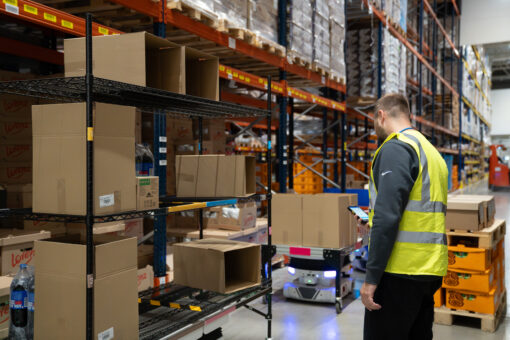WP: How to achieve 400 UPH with Locus Fast Pick
WP: How to achieve 400 UPH with Locus Fast Pick Download Now!
Debunking 10 Top Warehouse Fears About Robotic Automation
Mary Hart, Sr. Content Marketing Manager

Warehouse automation holds great promise for increasing productivity and efficiency while counteracting continuing challenges of labor costs and shortages, peak seasons and fluctuating order volumes, and demanding SLAs.
But some warehouse and fulfillment center managers (and employees!) may still be nervous about deploying robots or other automation into their facilities. Here are 10 common fears managers may have, along with perspectives to help overcome them.
High Costs
Upfront investment in robots can be daunting and hurt your warehouse’s bottom line. But with our robots-as-a-service (RaaS) subscription models, costs shift to flexible operating expenses aligned with your warehouse’s business needs. Shortened warehouse automation ROI timeframes also make projects more financially feasible.
Technical Challenges
While no solution is maintenance-free, today's robots are designed for simplicity. With cloud-based software, deployments can start quickly. Cloud-based deployment means new robots can be mapped into your warehouse digitally and updated remotely, ensuring faster go-live times and reduced IT strain.Vendors also provide support resources to smooth operations.
Also, training is a breeze with our AMRs. Human workers can understand how to work with our display screens and technology in just 15 minutes instead of the days and weeks it can take with other systems.
Security Risks
Security and privacy should always be top of mind. Reputable vendors employ encryption, access controls, and other measures to safeguard systems. Proper IT diligence is still needed, as with any technology.
Warehouses trust us to increase their efficiency and pick more units each day with fulfillment center automation.. That’s why we work every day to strengthen and keep that trust through ongoing security and compliance reviews, certifications, policies, and best practices.
Inflexibility
Robots can seem rigid, but many are highly configurable and adaptable. For example, AMRs can be easily reassigned to new workflows (like picking, putaway, and point-to-point transport) or locations as needs change. Built-in flexibility ensures long-term utility.
Integration Hurdles
No automation tool is an island. But open architectures, APIs and experienced integration teams make it straightforward to connect new technologies with existing WMS and other core systems.
For example, Locus AMRs connect with leading WMS platforms through RESTful APIs, allowing real-time data exchange for picking, inventory, and replenishment workflows without disrupting existing systems.
Worker Resistance
Change can be uncomfortable. Rollouts should emphasize how automation assists workers, instead of replacing them. Hands-on exposure and training also ease anxieties and build operator confidence.
Human workers love working alongside our AMRs. The robots create a “cool” factor in the warehouse or fulfillment center and workers can be upskilled into positions at the facility that better use their brain.
Job Loss
Robots are best suited for dangerous, strenuous, and tedious jobs, freeing up humans for more complex, strategic work. The goal is to augment human capabilities, not replace them.
With warehouse automation solutions like autonomous mobile robots (AMRs) from Locus Robotics, the robots work alongside the humans instead of replacing them.
Safety Risks
Safety is the top priority with any industrial equipment. Robots feature multiple safety sensors like LiDAR, collision avoidance, and other features to operate safely around people. Proper training and procedures are still essential.
Accuracy Concerns
Automation reduces human errors, but no system is infallible. The key is implementing checks and balances, such as validation steps and sensors to verify operations. This delivers consistent, superior quality.
With our AMRs working alongside human workers, warehouses and fulfillment centers have actually improved their accuracy rates to 99.9%.
Lack of Support
At Locus Robotics, we provide 24/7 support via hotline, dedicated customer success managers, on-site technicians for major rollouts, and proactive monitoring of AMR fleets. Training programs are tailored for warehouse associates and IT teams to ensure your staff is fully equipped to maximize system performance. Seek partners willing to be actively involved in your success as Strong cooperation is key.
Automation fears are normal. But looking at the facts alongside benefits like improved productivity and worker safety and health can help managers embrace warehouse automation solutions confidently. With the right perspective and partners, automation can transform operations for the better.
Ready to start thinking about automation? Watch our on-demand SupplyChainBrain webinar, “I Need to Add Automation: So, Now What?”, to learn more.




